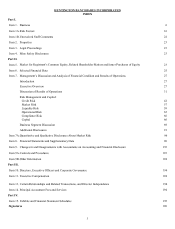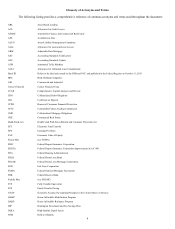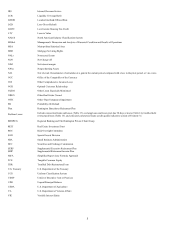Huntington National Bank 2014 Annual Report Download - page 17
Download and view the complete annual report
Please find page 17 of the 2014 Huntington National Bank annual report below. You can navigate through the pages in the report by either clicking on the pages listed below, or by using the keyword search tool below to find specific information within the annual report.11
Banking regulatory agencies have increasingly over the last few years used their authority under Section 5 of the Federal Trade
Commission Act to take supervisory or enforcement action with respect to UDAP by banks under standards developed many years
ago by the Federal Trade Commission in order to address practices that may not necessarily fall within the scope of a specific banking
or consumer finance law. The Dodd-Frank Act also gave to the CFPB similar authority to take action in connection with unfair,
deceptive or abusive acts or practices by entities subject to CFPB supervisory or enforcement authority.
Large bank holding companies and national banks are required to submit annual capital plans to the Federal Reserve and OCC,
respectively, and conduct stress tests.
The Federal Reserve’s Regulation Y requires large bank holding companies to submit capital plans to the Federal Reserve on an
annual basis and to require such bank holding companies to obtain approval from the Federal Reserve under certain circumstances
before making a capital distribution. This rule applies to us and all other bank holding companies with $50 billion or more of total
consolidated assets.
A large bank holding company’s capital plan must include an assessment of the expected uses and sources of capital over at least
the next nine quarters, a description of all planned capital actions over the planning horizon, a detailed description of the entity’s
process for assessing capital adequacy, the entity’s capital policy, and a discussion of any expected changes to the bank holding
company’s business plan that are likely to have a material impact on the firm’s capital adequacy or liquidity. The planning horizon for
the most recent capital planning and stress testing cycle encompasses the 2014 fourth quarter through the 2016 fourth quarter as was
submitted in our capital plan in January 2015. Rules to implement the Basel III capital reforms in the United States were finalized in
July 2013 and will be phased-in by us beginning with 1Q 2015 results under the standardized approach. As such, the most recent
CCAR cycle, which began October 1, 2014, overlaps with the implementation of the Basel III capital reforms based on the required
nine quarter projection horizon. In accordance with stress test rules, we incorporated the revised capital framework into the capital
planning projections and into the stress tests required under the Dodd-Frank Act. Capital adequacy at large banking organizations,
including us, is assessed against a minimum 4.5 percent tier 1 common ratio and a 5 percent tier 1 leverage ratio as determined by the
Federal Reserve.
Capital plans for 2015 were required to be submitted by January 5, 2015. The Federal Reserve will either object to a capital plan,
in whole or in part, or provide a notice of non-objection no later than March 31, 2015, for plans submitted by the January 5, 2015,
submission date. If the Federal Reserve objects to a capital plan, the bank holding company may not make any capital distributions
other than those with respect to which the Federal Reserve has indicated its non-objection. While we can give no assurances as to the
outcome or specific interactions with the regulators, based on the capital plan we submitted on January 5, 2015, we believe we have a
strong capital position and that our capital adequacy process is robust.
In addition to the CCAR submission, section 165 of the Dodd-Frank Act requires that national banks, like The Huntington
National Bank, conduct annual stress tests for submission in January 2015. The results of the stress tests will provide the OCC with
forward-looking information that will be used in bank supervision and will assist the agency in assessing a company’s risk profile and
capital adequacy. We submitted our stress test results to the OCC on January 5, 2015.
The regulatory capital rules indicate that common stockholders’ equity should be the dominant element within Tier 1 capital and
that banking organizations should avoid overreliance on non-common equity elements. Under the Dodd-Frank Act, the ratio of
common equity Tier 1 to risk-weighted assets became significant as a measurement of the predominance of common equity in Tier 1
capital and an indication of the quality of capital.
Conforming Covered Activities to implement the Volcker Rule.
On December 10, 2013, the Federal Reserve, the OCC, the FDIC, the CFTC and the SEC issued final rules to implement the
Volcker Rule contained in section 619 of the Dodd-Frank Act, and established July 21, 2015, as the end of the conformance period.
Section 619 generally prohibits insured depository institutions and any company affiliated with an insured depository institution from
engaging in proprietary trading and from acquiring or retaining ownership interests in, sponsoring, or having certain relationships with
a hedge fund or private equity fund. These prohibitions are subject to a number of statutory exemptions, restrictions, and definitions.
On December 18, 2014, The Federal Reserve Board announced it acted under Section 619 to give banking entities until July 21, 2016,
to conform investments in and relationships with covered funds and foreign funds that were in place prior to December 31, 2013
("legacy covered funds"). The Board also announced its intention to act next year to grant banking entities an additional one-year
extension of the conformance period until July 21, 2017, to conform ownership interests in and relationships with legacy covered
funds. The Bank continues its “good faith” efforts to conform with proprietary trading prohibitions and associated compliance
requirements. The company does not expect Volcker compliance to have a material impact on its business model.
























